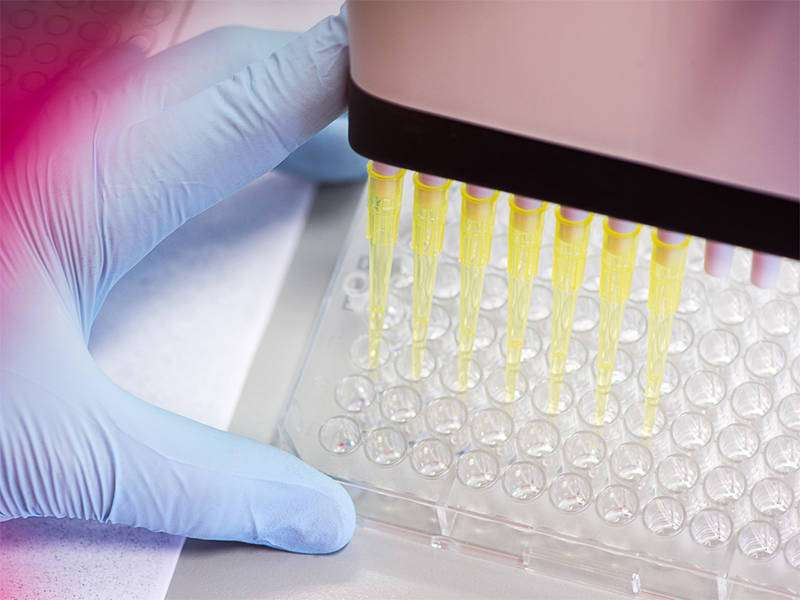Immunotherapy for cancer: New method identifies target antigens by mass spectrometry

New cancer therapies harness the immune system to fight tumors. One of the main principles behind these therapies is to find out precisely which molecules on cancer cells trigger an immune response. A team at the Technical University of Munich (TUM) and the Max Planck Institute of Biochemistry has for the first time identified suitable protein structures directly from patients' tumor cells. Unlike former approaches, their method does not rely on prediction algorithms but makes use of mass spectrometry. The procedure therefore opens up new possibilities for individualized targeted cancer treatments.
Through evolution, the immune system has developed sophisticated mechanisms for fighting illnesses associated with viruses and tumors. T cells play an important role in this setting. They can identify small protein structures, known as peptides, on cells. The body's own cells "present" the peptides on their surface and thus offer information about molecules on the inside. Individual peptides may, for example, indicate a viral infection or a mutation - the latter being a characteristic of tumor cells. Peptides identified by immune cells are known as antigens. T cells that recognize antigens can trigger a reaction that destroys the targeted cells.
In recent years research teams, including TUM researchers, have successfully utilized this characteristic for cancer treatments. Different approaches have emerged. Vaccinating a patient with an antigen can stimulate the body to enhance the production of specific T cells. Another possibility is to enrich T cells that are "trained" for certain antigens and transfer them to the patient.
In both cases, it is important to know which antigens derived from viruses or tumors may be recognized by the T cells. Many different peptides can be found on the body's own cells and cancer cells. Consequently, the pool of potential candidates when searching for suitable antigens is very large. The authors of the new study identified approximately 100,000 different peptides from tumor tissue samples derived from only 25 melanoma patients. The T cells are particularly good at identifying peptides on tumor cells with mutations, i.e. structural changes. The peptides that mutate and the type of mutations they undergo generally varies from one patient to another.
Time-consuming and error-prone search for antigens
In the past, the search for mutated peptides actually presented on the tumor was a time-consuming and error-prone process. Scientists had to start by sequencing the DNA from tumor cells. That process alone takes one to two weeks. The sequencing data is then fed into prediction algorithms to determine which mutated peptides might be found on the surface of the cell. Subsequently, time-consuming laboratory experiments had to be performed in order to find out whether these molecules actually existed and were presented on the cell surface.
An alternative to this process has now been developed by a team led by Angela M. Krackhardt, professor of translational immunotherapy at the Third Medical Clinic at TUM's Klinikum rechts der Isar, and Professor Matthias Mann of the Department of Proteomics and Signal Transduction at the Max Planck Institute of Biochemistry. Krackhardt and Mann have described their approach in an article published in the journal Nature Communications. Unlike other methods, it is not based on predictive models. Instead, the scientists use a mass spectrometer to identify the peptides actually present on the tumor surface.
Accurate and time-saving
The genomic sequence, or blueprint, of the tumor cells is also required for the new method. At the same time, surface structures of the malignant cell - in this case presented peptides - are removed directly from tumor tissue and investigated by mass spectrometry. Combining both analyses by bioinformatics results in the identification of mutated antigens actually presented on the cells with considerable accuracy.
The team headed by Krackhardt and Mann was also able to demonstrate the clinical relevance of the new method: In the blood of melanoma patients they found T cells that recognized tumor cells by means of antigens identified with mass spectrometry.
The new approach offers numerous advantages. By avoiding time-consuming simulations and laboratory experiments, information on mutated peptides on the tumor cells is much faster available. "For the first time, we have used the mass spectrometer to investigate not just expanded, cells, but rather heterogeneous tumor tissues of real patients," adds Matthias Mann. "That gives us much more detailed information about the molecular characteristics of the tumor." Moreover, the method is highly sensitive. The results of the study are already serving as the starting point for promising research initiatives, for example on the role of phosphorylated peptides.
Angela Krackhardt sees no major obstacles for clinical application of the method. "Our approach opens up new possibilities for the personalized treatment of cancer," says Krackhardt. "Identification of suitable antigens by this method will allow us to provide individualized vaccines or adoptive T-cell therapies for our patients within weeks to a few months."
More information: Michal Bassani-Sternberg et al, Direct identification of clinically relevant neoepitopes presented on native human melanoma tissue by mass spectrometry, Nature Communications (2016). DOI: 10.1038/ncomms13404

















